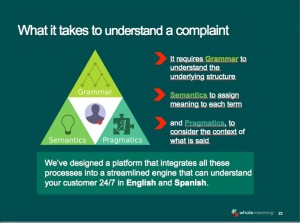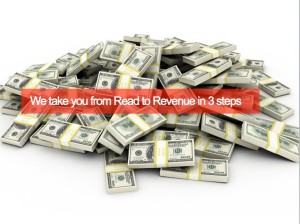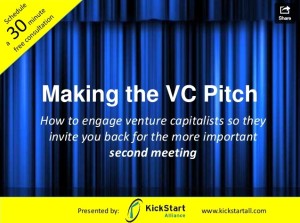Entrepreneurs and start-up executives continue to struggle with the best way to present their company to venture capitalists and their target customers. Especially for early stage companies, their personal and professional credibility are on the line. Unfortunately, the most common first slides I see startup executives present are either about themselves or a history lesson about technology. There is a much, much better way to open the door.
And so I was delighted to meet Andres Vergara, CEO of a startup called WholeMeaning. WholeMeaning is a social media listening post. They provide an enterprise feedback management system that pays attention to customer feedback in all its forms, listening not only to the words used, but the sentiment and context around those words. Andres’s introductory presentation is near perfect, taking full advantage of three best practices that are designed to engage his audiences. To be clear, he has two separate audiences with similar goals: VCs and senior executives of target prospects. While he wants different things from each audience, he must present his company’s value proposition clearly and succinctly to get them to engage in a productive conversation. Here’s what he’s done.
1) Lead with the customer problem
Nothing speaks louder than a customer problem his audience can relate to. In a simple slide he’s captured an extremely compelling scenario that anybody can relate to. The “United Breaks Guitars” public relations disaster quickly communicates the business problem he wants to help his customers solve. Check out the story here and watch the entertaining video of the hit song here. In short, this easily avoidable disaster to United Airlines cost them more than 10 million negative reviews on social media channels and more than $180 million in decreased valuation.
He could have easily led with an initial slide about his deep industry background, or the technology his listening engine takes advantage of. But neither of these strike a chord of engagement and empathy that his case study does. He’s hooked his audience. The hard part is done. Now, to the details.
2) Simplify the value proposition
WholeMeaning takes companies from “read to revenue in 3 steps.” That sounds pretty compelling. When Andres presents this slide you can feel the VCs and prospects lean forward. Ok. how do you do this? How does this work? And this is exactly the reaction you want. By simplifying the value proposition he has eliminated the confusion of what is really being delivered. Sure, there is a lot of noise in the marketplace, and it’s one thing to be able to listen to the customer complaints. But the real value comes from being able to understand the information, analyze it, and turn it into revenue and brand-building opportunities. There is no confusion. Woven into this slide and the technology-related slides that follow, Andres reinforces the value, not the technology. VCs and prospects will nod their heads.
- Understanding the customer experience is the most important key to increasing customer retention. Companies need a cost-effective and scalable way to continuously listen and extract insights from all customers.
- Customers like to experess their feelings in their own words, but don’t like to answer a lot of questions.
- Customers will passionately tell you the “why” behind their buying behaviors and “how” to improve things to better their experience.
- It is critical to tie “customer metrics” with “transaction metrics” or “demographic metrics” to turn customer insights into business insights.
3) Ending with customer success & call to action
Including a story of how his product has been put to the test with a real company is a strong way to finish the presentation. Even if the case study is only a beta. Even if the customer didn’t pay for this because you provided the service for free. The story of value provided and value acknowledged is extremely important and compelling. Yes, Ander’s company is a startup. He’s raising money to secure the next round of companies. But the value proposition has been proven.

Simplify how technology supports the value proposition. Save the technology details for the second meeting.
This then, easily transitions into the call to action discussion. It’s often best to treat this part of the presentation as a conversation. But, the “ask” should be clear. Decide which next steps are most important to you.
It can be intimidating reaching out to people we don’t know when we want to introduce ourselves and our companies. The common default way to start a dialog is in talking about ourselves and technology. But this is exactly the WRONG way to start a discussion. Instead, follow the example illustrated by Andres. Chances are good you will be invited back for the ever-so-more-important second meeting.
For more information
For more information on how to structure your presentation to VCs or your first set of customers, check out my slides: Making the Pitch.
Good luck!





